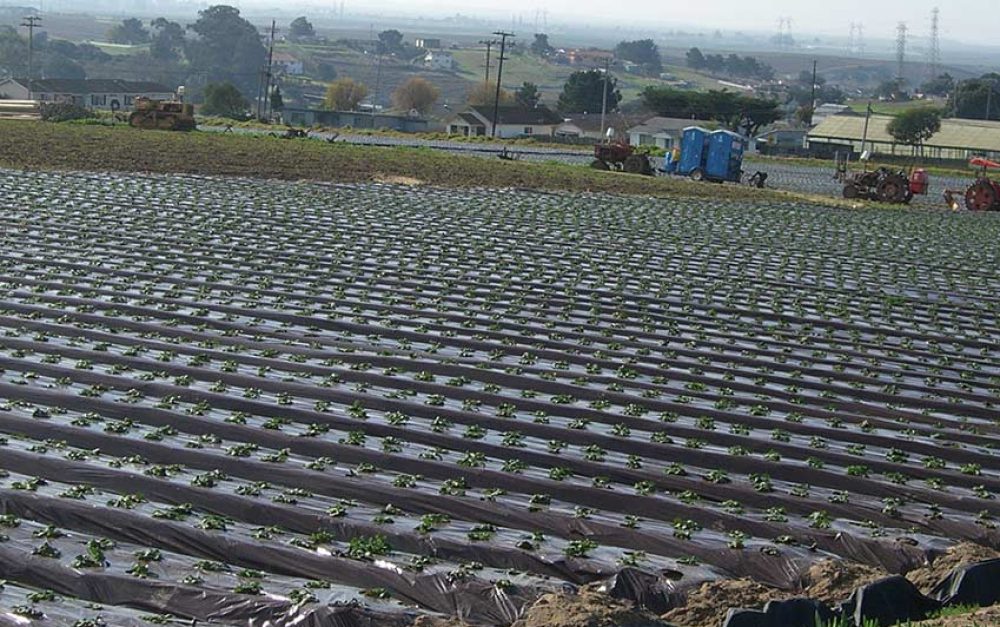What’s being applied on the strawberry field next door? For many Californians, the answer is a big question mark. And the issue has taken on added significance as state officials consider how best to answer that question — and then inform parents about the health-harming pesticides being applied near homes and schools.
According to a 2014 report from the California Department of Public Health, fumigants are the top five pesticides most commonly used near schools. And with more than 25 million pounds applied annually on strawberry fields, they’re the most widely used pesticide across the state. Fumigants are also applied on hundreds of thousands of acres of almonds, carrots, sweet potatoes and grapes.
Given that California has a pesticide use reporting system in place — the best in the country — it may come as a surprise that Californians don’t often know when fumigants are being applied nearby until long after the fact. That information is commonly not available until up to a year later, if ever.
This is a problem. Fumigants are often applied as gasses, and they’re infamous for drifting from fields to neighboring homes or schools. People are being impacted by exposure to drift as the fumigants are applied; finding out a year later does nothing to protect the health of those who live, learn and play in the area.
Notification is just the beginning
Better fumigant notification is essential to allow parents, neighbors and policymakers to make real-time decisions for their families and communities. Notification also makes it much easier to identify the cause of illness symptoms and get appropriate medical treatment. Notification will benefit the public, inspectors and farming operations by allowing rapid detection of sources of fumigant drift before large numbers of people are impacted.
For years, the only pesticide that required neighbor notification was methyl bromide. But as that pesticide is being phased out under international treaty, other fumigants are being phased in. Dow’s 1,3-dichloropropene (“Telone”), a known carcinogen, is quickly taking the place of methyl bromide. And its use has grown thanks to a glaring state loophole.
At a couple workshops later this month (please consider attending!) set to inform new schools-specific draft rules, the California Department of Pesticide Regulation (DPR) will consider providing better notification. It’s about time.
Necessary changes
It’s not enough to just post a sign once, or warn neighbors months before a potential application. Parents need information to make better decisions. From Watsonville to Red Bluff, community members are pushing for better protections for their kids and neighboring school kids from hazardous strawberry fumigants.
Justin Matlow, a special education teacher in Watsonville, described the situation like this in an opinion piece for The Mercury News:
If pesticide use continues within a mile of schools, advance notification should be provided to schools and relayed to the parents and teachers. Counties should establish a website to inform the community of when and where pesticides are being applied. These are important first steps that DPR can take toward protecting our communities.”
At PAN we’ve been making the case for comprehensive notification, along with colleagues at Californians for Pesticide Reform, California Rural Legal Assistance Foundation, among others. We’re urging policymakers to institute the following:
- 1-mile notification: Notification should be provided to all schools and daycare centers within one mile of planned field fumigation, given the likelihood of drift.
- Bilingual notification: Written bilingual notification should be provided at least one week prior to a scheduled fumigation either by mail or hand delivery.
- School notification: When a school is in the notification zone, parents should receive notification via “robo-call” systems which schools use for many types of notice; the written notice should also be posted at the school and on the school website.
- Informed decisionmakers: If state air monitoring shows increased levels of fumigants in the air, local decisionmakers and residents must be notified immediately.
Notification of field fumigations is vital, but it’s also not enough. Use of soil fumigants needs to be phased out and replaced with cutting-edge, effective methods that build soil health — and protect children. It’s good news to see some of this funded through DPR’s research grants (full disclosure: I sit on the grants advisory committee), but more is needed.
It’s clear that in order to transition from fumigants by the year 2020, DPR needs a more comprehensive program to provide incentives, training and pilot projects. Let’s make it happen.
Photo: By Calbear22 at English Wikipedia – Transferred from en.wikipedia to Commons by Optigan13 using CommonsHelper., Public Domain, https://commons.wikimedia.org/w/index.php?curid=8385744








